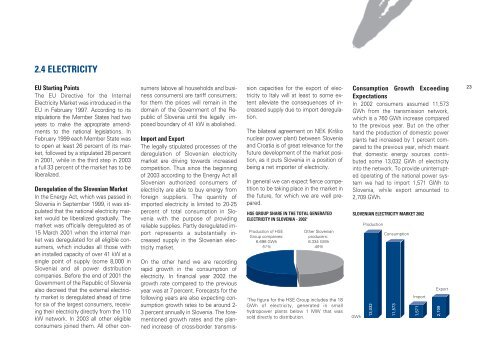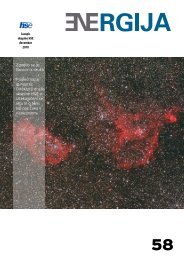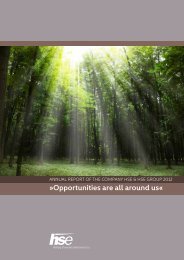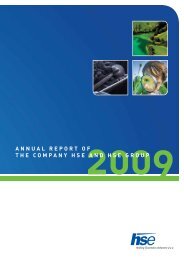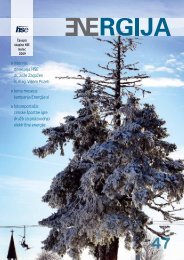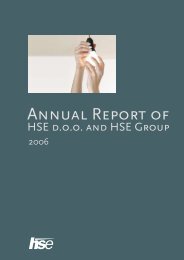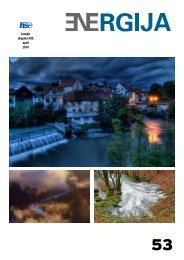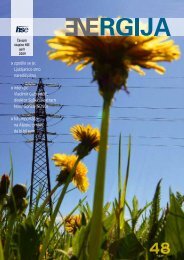hse group
hse group
hse group
You also want an ePaper? Increase the reach of your titles
YUMPU automatically turns print PDFs into web optimized ePapers that Google loves.
2.4 ELECTRICITY<br />
EU Starting Points<br />
The EU Directive for the Internal<br />
Electricity Market was introduced in the<br />
EU in February 1997. According to its<br />
stipulations the Member States had two<br />
years to make the appropriate amendments<br />
to the national legislations. In<br />
February 1999 each Member State was<br />
to open at least 26 percent of its market,<br />
followed by a stipulated 28 percent<br />
in 2001, while in the third step in 2003<br />
a full 33 percent of the market has to be<br />
liberalized.<br />
Deregulation of the Slovenian Market<br />
In the Energy Act, which was passed in<br />
Slovenia in September 1999, it was stipulated<br />
that the national electricity market<br />
would be liberalized gradually. The<br />
market was officially deregulated as of<br />
15 March 2001 when the internal market<br />
was deregulated for all eligible consumers,<br />
which includes all those with<br />
an installed capacity of over 41 kW at a<br />
single point of supply (some 8,000 in<br />
Slovenia) and all power distribution<br />
companies. Before the end of 2001 the<br />
Government of the Republic of Slovenia<br />
also decreed that the external electricity<br />
market is deregulated ahead of time<br />
for six of the largest consumers, receiving<br />
their electricity directly from the 110<br />
kW network. In 2003 all other eligible<br />
consumers joined them. All other consumers<br />
(above all households and business<br />
consumers) are tariff consumers;<br />
for them the prices will remain in the<br />
domain of the Government of the Republic<br />
of Slovenia until the legally imposed<br />
boundary of 41 kW is abolished.<br />
Import and Export<br />
The legally stipulated processes of the<br />
deregulation of Slovenian electricity<br />
market are driving towards increased<br />
competition. Thus since the beginning<br />
of 2003 according to the Energy Act all<br />
Slovenian authorized consumers of<br />
electricity are able to buy energy from<br />
foreign suppliers. The quantity of<br />
imported electricity is limited to 20-25<br />
percent of total consumption in Slovenia<br />
with the purpose of providing<br />
reliable supplies. Partly deregulated import<br />
represents a substantially increased<br />
supply in the Slovenian electricity<br />
market.<br />
On the other hand we are recording<br />
rapid growth in the consumption of<br />
electricity. In financial year 2002 the<br />
growth rate compared to the previous<br />
year was at 7 percent. Forecasts for the<br />
following years are also expecting consumption<br />
growth rates to be around 2-<br />
3 percent annually in Slovenia. The forementioned<br />
growth rates and the planned<br />
increase of cross-border transmission<br />
capacities for the export of electricity<br />
to Italy will at least to some extent<br />
alleviate the consequences of increased<br />
supply due to import deregulation.<br />
The bilateral agreement on NEK (Krπko<br />
nuclear power plant) between Slovenia<br />
and Croatia is of great relevance for the<br />
future development of the market position,<br />
as it puts Slovenia in a position of<br />
being a net importer of electricity.<br />
In general we can expect fierce competition<br />
to be taking place in the market in<br />
the future, for which we are well prepared.<br />
HSE GROUP SHARE IN THE TOTAL GENERATED<br />
ELECTRICITY IN SLOVENIA - 2002 1<br />
Production of HSE<br />
Group companies:<br />
6.698 GWh<br />
51%<br />
Other Slovenian<br />
producers:<br />
6.334 GWh<br />
49%<br />
1<br />
The figure for the HSE Group includes the 18<br />
GWh of electricity, generated in small<br />
hydropower plants below 1 MW that was<br />
sold directly to distribution.<br />
Consumption Growth Exceeding<br />
Expectations<br />
In 2002 consumers assumed 11,573<br />
GWh from the transmission network,<br />
which is a 760 GWh increase compared<br />
to the previous year. But on the other<br />
hand the production of domestic power<br />
plants had increased by 1 percent compared<br />
to the previous year, which meant<br />
that domestic energy sources contributed<br />
some 13,032 GWh of electricity<br />
into the network. To provide uninterrupted<br />
operating of the national power system<br />
we had to import 1,571 GWh to<br />
Slovenia, while export amounted to<br />
2,709 GWh.<br />
SLOVENIAN ELECTRICITY MARKET 2002<br />
GWh<br />
Production<br />
13,032<br />
Consumption<br />
11,573<br />
Import<br />
1,571<br />
Export<br />
2,709<br />
23


